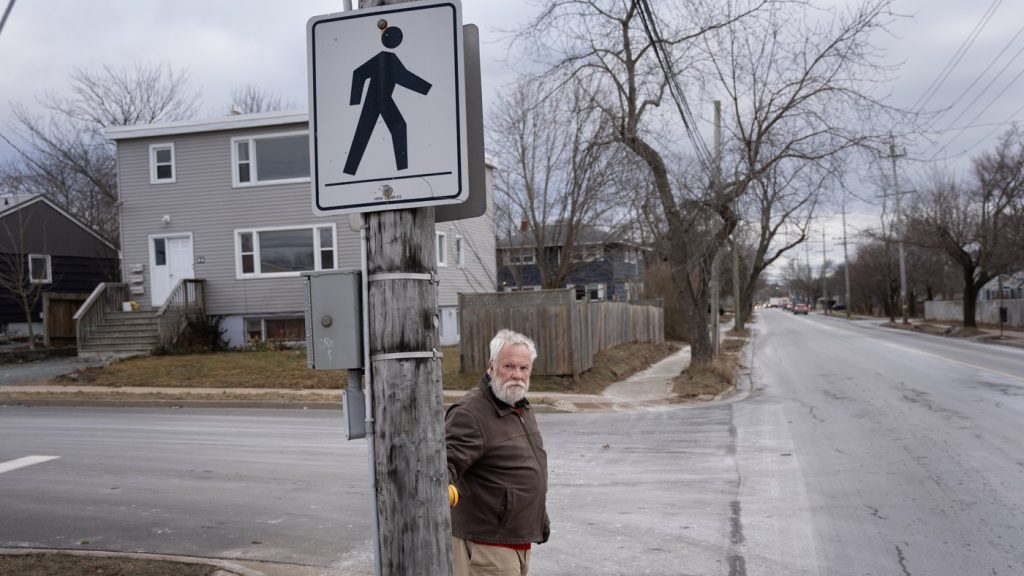Pedestrian injuries: Advocate says Halifax goals for safety unmet after walker killed

Posted Jan 8, 2025 05:03:01 PM.
Last Updated Jan 9, 2025 01:38:18 PM.
Halifax safety advocates are calling for government action to reduce the number of pedestrians injured or killed by cars, after the death of a senior who was hit while walking on a marked crosswalk earlier this week.
The city set a goal in 2018 to cut the number of pedestrians killed or injured in collisions by 20 per cent over five years, but data show that target wasn’t reached. As well, police are distributing significantly fewer tickets in recent years for speeding or distracted driving, the data show.
“Basically, we aren’t achieving the goals … with respect to pedestrian injuries,” Norm Collins, who founded the Crosswalk Safety Society of Nova Scotia eight years ago, said Tuesday in a telephone interview.
On Monday, a 72-year-old man died in hospital after he was struck on a pedestrian crossing equipped with flashing amber lights shortly after 7 a.m. Police issued a summary offence ticket to a 30-year-old driver for failing to yield to a pedestrian in a crosswalk. The investigation is ongoing, they said.
About one or two pedestrians have been killed by vehicles each year in Halifax since 2020, police records show, and the number of pedestrians injured in collisions has remained stable, rising to 149 in 2024 from 146 in 2018.
Collins says the data show the city is failing to meet its 2018 goal of reducing injuries or deaths by 20 per cent over five years. He’s calling for improvements in traffic enforcement and engineering, with tougher treatment of speeders at the top of his list.
Provincial data he’s obtained show that policing agencies in Halifax issued about 12,000 tickets in 2012, compared with about 1,900 in 2023. Those statistics show a sharp drop over 10 years in the number of fines given by police for using a smartphone while driving, with figures falling from about 10,000 tickets in 2012 to about 1,300 in 2023.
“When you speed in a car, you’re less likely to react in a timely manner to a pedestrian crosswalk,” said Collins. “And if you do hit a pedestrian, it’s more likely to cause serious injury.”
He said the “significant decline” in tickets for distracted driving and speeding, “is not leading to any deterrence.”
Traffic safety is on the agenda this month for Halifax’s transportation committee, said its chair, Coun. Sam Austin. “If the (traffic safety) plan’s not working, we’re going to have to adjust it,” he said.
Austin also said the province should bring into force legislation that would allow the city to introduce traffic camera systems to monitor speeding. The city wants the new technology because it’s cheaper than deploying more officers to monitor traffic, Austin said.
“We’ve been waiting years now to be able to deploy cameras,” said Austin. “We’ve already done the study work to do this here in Halifax. But we’re still not there, and that is frustrating.”
Marla MacInnis, a spokeswoman for the police, said traffic cameras are being used successfully in other jurisdictions as a way to monitor and enforce safer driving. She said the police force would be “very interested in exploring” use of the technology “if and when the Traffic Safety Act is proclaimed.”
Collins and Austin both say that traffic engineering changes around crosswalks need to be reviewed to heighten driver awareness.
Collins noted that in recent years there have been some improvements, including the installation at some busy corners of a system that gives pedestrians a seven-second head start to walk into an intersection before motorists receive a green light.
But he said he now believes the city should consider further measures, such as putting in rumble strips, which are grooved patterns in the pavement that alert drivers as they approach a pedestrian crosswalk.
Martyn Williams, also an advocate for pedestrian and cyclist safety, said in an email that there’s growing research to suggest crosswalks with overhead, flashing amber lights often don’t result in drivers yielding. He said some traffic engineering studies suggest that when the flashing lights are replaced by traffic half-signals — lights that turn red only when pedestrians need to cross — vehicles are likelier to stop.
Williams also said that if better lighting technology isn’t a solution, the city should create a “pinch point” for drivers by merging traffic lanes as cars approach an intersection.
Austin said council would need to seek studies and proposals from its own staff to assess the various engineering solutions.
Lee Warren, whose mother died when a car hit her in a marked crosswalk in 2020 in the suburb of Dartmouth, said in an interview Wednesday that each time someone dies or is injured in an intersection it’s distressing and disappointing for families that have suffered similar tragedies.
“I’m sad to hear that another family has to deal with a death related to a pedestrian fatality in a marked crosswalk,” he said.
Warren said after his mother died, changes were made to the intersection near the scene of the fatal collision, but he added, “obviously, there’s more to do.”
This report by The Canadian Press was first published Jan. 8, 2025.
Michael Tutton, The Canadian Press
<!– Photo: 49932e0616997309a49579fb0c36084546b878c8dfa95297c7de5566aa4b656c.jpg, Caption:
Crosswalk safety advocate Norm Collins stands at the site of the latest pedestrian casualty, where a 72-year-old man was struck and killed Monday, in Halifax, Wednesday, Jan. 8, 2025. THE CANADIAN PRESS/Darren Calabrese
–>
<!– Photo: 68d3fed9af5c1bec1ff9a1c921737b3b242783336d814b88e644986d497d5045.jpg, Caption:
Police tape blows in the wind at the site where a 72-year-old man was struck and killed Monday, in Halifax, Wednesday, Jan. 8, 2025. THE CANADIAN PRESS/Darren Calabrese
–>








